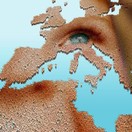Winners
The Computer Graphics Forum 2005 Cover Image has been selected by the CGF editorial board. We thanks all people who submitted this year, and hope that they will participate to the next year contest.
Winner of the Computer Graphics Forum 2005 Cover Image Contest

Clavien Mireille
Virtual Reality Lab, Swiss Federal Institute of Technology, Lausanne, Switzerland
The image is a snapshot of real-time OpenGL rendering from CrowdBrush, a tool
for intuitive authoring of real-time crowd scenes (by Ulicny, de Heras
and Thalmann, Proc. ACM SIGGRAPH / EG Symposium on Computer Animation '04).
It contains around 32 thousand of animated 3D virtual humans arranged and colored
according to a bitmap image with a transparency layer.
Second place(ex aequo):

Jurgen Brickmann, T. Borosch, M. Keil and O. Korb
Darmstadt University of Technology, Germany
The image is generated with the molecular visualization programm MOLCAD that has been
developed in the group of Prof. J. Brickmann (Darmstadt University of Technology) and
is distributed by Tripos, Inc. as part of the widespread molecular modelling package SYBYL.
The picture is representing the capsid of the Tobacco Ringspot Virus. The skeletal
structure of the virus is based on experimentally derived X-ray coordinates of atoms
(some of the ~240.000 atoms can be seen in the left part of the picture).
The blue "ribbon" represents the main chain ("backbone") of the protein chain that builds
up the virus capsid. The green "molecular surface" was generated using a grid-based,
marching-cube algorithm implemented in MOLCAD.
To get a view inside the virus, clipping-planes were applied to the surface, ribbon and
the molecular representation to cut the appropriate parts of the objects. The inner "glow"
is a volume-rendered representation of a 3D-data-field, representing the distance to
the molecular surface of the capsid.
The distance is coded by different colors and alpha-values. Usually, the complete scene
can be changed interactively as the tool is used for the 3D-analysis of complex macromolecules
like proteins or DNA.

Gene Lin
Department of Computer and Information Science, National Chiao Tung University, Hsin Chu, Taiwan
The Chinese Painting in this image is painted with my Ink Diffusion model which
can simulate the physical interactions between the Hsuan paper and ink.
I use Kubelka-Munk Theory as my color model to create the blending effects of colors.
The scene is quite simple, including a paper, a floor and a man drawing. I try to render
the scene as simple as possible to emphasize the beauty to Chinese Painting.
